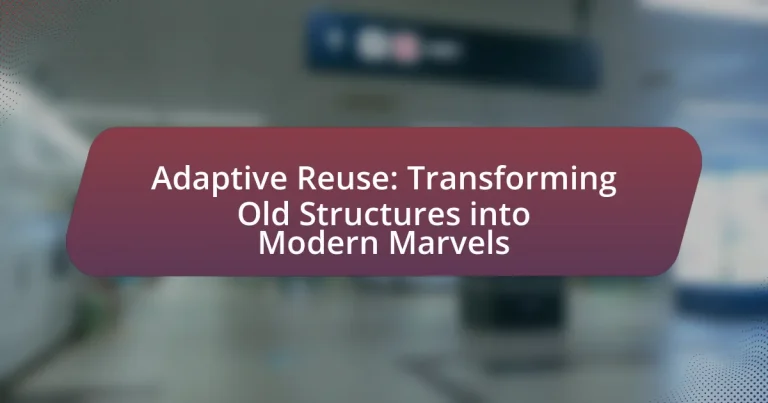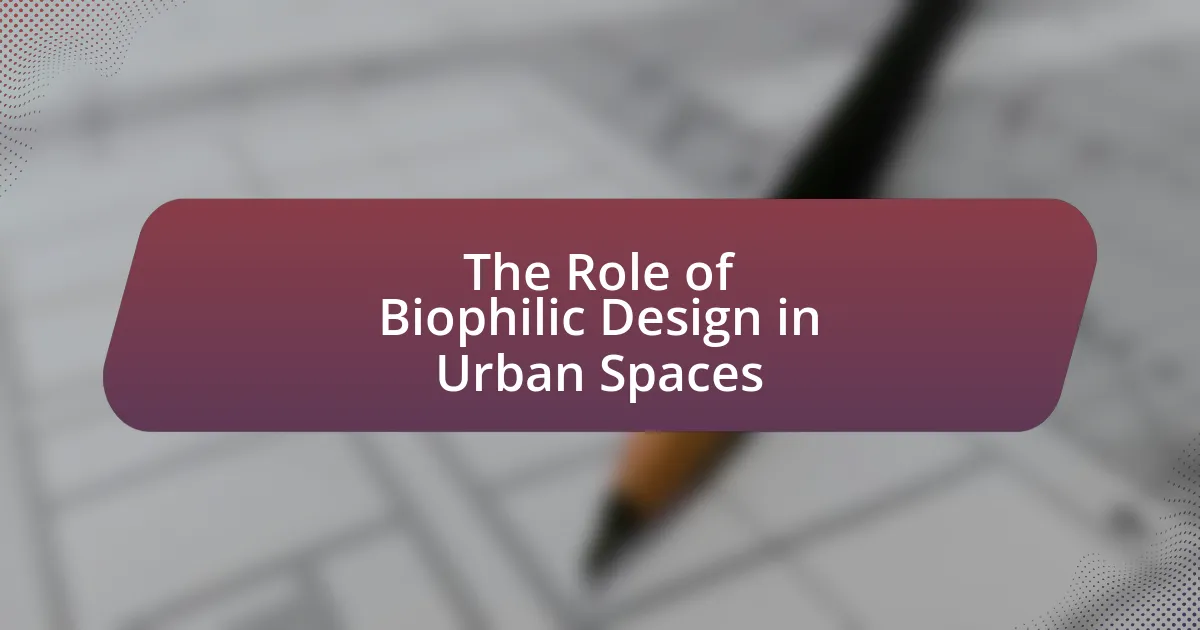Adaptive reuse is the process of repurposing old buildings for new uses while preserving their historic features, promoting sustainability, and reducing waste. This article explores the differences between adaptive reuse and traditional renovation, highlighting key principles such as sustainability, historical preservation, and community integration. It discusses the importance of adaptive reuse in urban development, the types of structures suitable for repurposing, and the environmental benefits associated with this practice. Additionally, the article addresses challenges faced in adaptive reuse projects, including regulatory hurdles and financial considerations, while showcasing successful examples like the High Line in New York City and the Tate Modern in London. Finally, it outlines best practices and innovative strategies for ensuring successful adaptive reuse outcomes while maintaining historical integrity.

What is Adaptive Reuse?
Adaptive reuse is the process of repurposing old buildings for new uses while retaining their historic features. This approach not only preserves cultural heritage but also promotes sustainability by reducing waste and minimizing the need for new construction materials. According to the National Trust for Historic Preservation, adaptive reuse can significantly lower carbon emissions associated with building demolition and new construction, making it an environmentally responsible choice.
How does Adaptive Reuse differ from traditional renovation?
Adaptive Reuse involves repurposing an existing building for a new use while retaining its historical features, whereas traditional renovation focuses primarily on updating or restoring a structure without necessarily changing its original purpose. Adaptive Reuse often emphasizes sustainability by minimizing waste and preserving cultural heritage, as seen in projects like the High Line in New York City, which transformed an old railway into a public park. In contrast, traditional renovation may prioritize aesthetic improvements or modern functionality without the same level of historical consideration or environmental impact.
What are the key principles of Adaptive Reuse?
The key principles of Adaptive Reuse include sustainability, historical preservation, functional adaptability, and community integration. Sustainability emphasizes minimizing waste and resource consumption by repurposing existing structures instead of demolishing them. Historical preservation focuses on maintaining the architectural integrity and cultural significance of the original building, ensuring that its historical value is respected. Functional adaptability involves modifying the space to meet contemporary needs while retaining its original character, allowing for diverse uses. Community integration ensures that the repurposed structure contributes positively to the surrounding environment and engages with the local community, fostering a sense of place and continuity. These principles collectively enhance the value of existing buildings while promoting environmental and social benefits.
Why is Adaptive Reuse important in urban development?
Adaptive reuse is important in urban development because it promotes sustainability by repurposing existing structures, thereby reducing waste and conserving resources. This practice minimizes the environmental impact associated with new construction, as it often requires fewer materials and less energy. For instance, a study by the National Trust for Historic Preservation found that adaptive reuse can save up to 50% of the energy required to build new structures. Additionally, adaptive reuse enhances community identity by preserving historical architecture, which fosters a sense of place and continuity. This approach not only revitalizes neighborhoods but also stimulates local economies by attracting businesses and tourism.
What types of structures can undergo Adaptive Reuse?
Various types of structures can undergo adaptive reuse, including industrial buildings, warehouses, schools, churches, and historic homes. Industrial buildings, such as factories, are often repurposed into residential lofts or commercial spaces due to their spacious layouts and robust construction. Warehouses can be transformed into retail centers or office spaces, capitalizing on their large open areas. Schools and churches frequently find new life as community centers or event venues, preserving their architectural significance while serving modern needs. Historic homes can be renovated into boutique hotels or restaurants, maintaining their heritage while adapting to contemporary functions. This versatility in adaptive reuse highlights the potential for sustainable development and preservation of cultural heritage.
How do historical buildings fit into Adaptive Reuse projects?
Historical buildings serve as foundational elements in Adaptive Reuse projects by providing a unique architectural heritage and cultural significance that can be preserved while repurposing the structure for modern use. These buildings often embody historical craftsmanship and design, which can enhance the aesthetic and functional value of new developments. For instance, the conversion of the Tate Modern in London, a former power station, into a contemporary art museum illustrates how historical structures can be transformed to meet current needs while retaining their historical essence. This approach not only conserves resources by minimizing demolition waste but also fosters community identity and continuity by maintaining landmarks that reflect local history.
What modern structures are commonly repurposed?
Modern structures commonly repurposed include warehouses, factories, schools, and churches. These buildings are often transformed into residential lofts, office spaces, cultural centers, and retail establishments. For example, the conversion of the High Line in New York City, a former elevated railway, into a public park illustrates the successful adaptive reuse of industrial infrastructure. This trend not only preserves historical architecture but also revitalizes urban areas, contributing to economic growth and sustainability.
What are the environmental impacts of Adaptive Reuse?
Adaptive reuse significantly reduces environmental impacts by minimizing waste and conserving resources. This practice repurposes existing buildings, which decreases the need for new construction materials, thereby lowering carbon emissions associated with manufacturing and transportation. According to the U.S. Environmental Protection Agency, adaptive reuse can divert up to 80% of construction and demolition debris from landfills. Additionally, it often leads to energy savings, as retrofitting older structures can be more energy-efficient than building new ones from scratch. Studies indicate that adaptive reuse projects can result in a 30-50% reduction in energy consumption compared to new constructions.
How does Adaptive Reuse contribute to sustainability?
Adaptive reuse contributes to sustainability by minimizing waste and reducing the demand for new materials. By repurposing existing structures, adaptive reuse conserves resources and energy that would otherwise be expended in new construction. For instance, a study by the National Trust for Historic Preservation found that reusing a building can save up to 80% of the embodied energy compared to demolishing it and constructing anew. This practice not only preserves historical and cultural value but also significantly lowers carbon emissions associated with construction activities.
What are the carbon footprint benefits of repurposing buildings?
Repurposing buildings significantly reduces carbon footprints by minimizing the need for new construction materials and preserving existing structures. This process conserves energy, as it often requires less energy to renovate an existing building than to demolish it and build anew. For instance, the National Trust for Historic Preservation states that reusing a building can save up to 80% of the carbon emissions associated with new construction. Additionally, repurposing reduces waste sent to landfills, as it diverts materials from demolition, further lowering environmental impact. Overall, adaptive reuse not only conserves resources but also contributes to sustainable urban development.

What challenges are associated with Adaptive Reuse?
Adaptive reuse faces several challenges, including structural integrity, regulatory compliance, and financial feasibility. Structural integrity issues arise when existing buildings do not meet modern safety standards or require significant repairs to support new uses. Regulatory compliance can be complex, as adaptive reuse projects must navigate zoning laws, building codes, and historic preservation regulations, which can vary widely by location. Financial feasibility is often a concern, as the costs associated with renovation and compliance can exceed initial budgets, making it difficult to secure funding or achieve a return on investment. These challenges necessitate careful planning and collaboration among architects, developers, and local authorities to ensure successful adaptive reuse projects.
What regulatory hurdles must be navigated in Adaptive Reuse projects?
Adaptive reuse projects must navigate several regulatory hurdles, including zoning laws, building codes, and historic preservation regulations. Zoning laws may restrict the types of activities allowed in a repurposed building, requiring changes to land use designations. Building codes often necessitate compliance with modern safety and accessibility standards, which can be challenging when retrofitting older structures. Additionally, historic preservation regulations may impose restrictions on alterations to buildings designated as historic, requiring approvals from local preservation boards. These regulatory frameworks are designed to ensure safety, maintain community standards, and protect cultural heritage, making them critical considerations in the adaptive reuse process.
How do zoning laws affect Adaptive Reuse?
Zoning laws significantly influence adaptive reuse by dictating the permissible uses of a property, which can either facilitate or hinder the transformation of existing structures. These regulations establish the types of activities allowed in specific areas, impacting decisions on whether a building can be repurposed for residential, commercial, or mixed-use developments. For instance, if a zoning ordinance restricts a former industrial building to manufacturing use only, it may prevent its conversion into residential lofts or retail spaces, thereby limiting adaptive reuse opportunities. Additionally, zoning laws may impose requirements such as parking ratios, building height restrictions, and design standards that can complicate or increase the costs associated with adaptive reuse projects.
What are the common financial challenges faced?
Common financial challenges faced in adaptive reuse projects include high renovation costs, securing financing, and navigating regulatory hurdles. Renovation costs can exceed initial estimates due to unforeseen structural issues, which is often cited in studies such as the National Trust for Historic Preservation’s report on adaptive reuse. Securing financing can be difficult as lenders may view these projects as risky investments, particularly if the market demand for the repurposed space is uncertain. Additionally, navigating regulatory hurdles, including zoning laws and building codes, can lead to delays and increased costs, as highlighted in various case studies on urban redevelopment.
How can community engagement influence Adaptive Reuse outcomes?
Community engagement significantly influences adaptive reuse outcomes by ensuring that the redevelopment aligns with local needs and values. When community members actively participate in the planning process, they provide insights that can lead to designs that enhance social cohesion and preserve cultural heritage. For instance, studies have shown that projects with strong community involvement tend to achieve higher levels of public support and satisfaction, as seen in the successful transformation of the High Line in New York City, where community input shaped the design and function of the space. This collaborative approach not only fosters a sense of ownership among residents but also increases the likelihood of sustainable and economically viable outcomes for adaptive reuse projects.
What role do local stakeholders play in the process?
Local stakeholders play a crucial role in the adaptive reuse process by providing insights, resources, and support that shape project outcomes. Their involvement ensures that community needs and values are considered, which can lead to greater acceptance and success of redevelopment initiatives. For instance, local stakeholders, including residents, business owners, and government officials, often participate in planning meetings and public consultations, allowing them to voice concerns and preferences. This collaborative approach can enhance project design and functionality, as evidenced by case studies where community input has led to more sustainable and culturally relevant outcomes in adaptive reuse projects.
How can public opinion shape project success?
Public opinion can significantly shape project success by influencing stakeholder support and funding opportunities. When a project garners positive public sentiment, it often leads to increased community backing, which can facilitate smoother approvals and reduce opposition. For instance, studies have shown that projects with strong public support are more likely to receive necessary permits and funding, as seen in the successful adaptive reuse projects in cities like San Francisco, where community engagement led to the revitalization of historic buildings. This demonstrates that aligning project goals with public interests can enhance overall project viability and success.

What are successful examples of Adaptive Reuse?
Successful examples of adaptive reuse include the High Line in New York City, which transformed an abandoned elevated railway into a public park, and the Tate Modern in London, which repurposed a former power station into a contemporary art museum. The High Line, completed in 2009, has become a model for urban revitalization, attracting millions of visitors annually and enhancing local property values. The Tate Modern, opened in 2000, has significantly contributed to the cultural landscape of London, drawing over 5 million visitors each year and showcasing the potential of reimagining industrial spaces for public use.
What notable projects exemplify Adaptive Reuse?
Notable projects that exemplify Adaptive Reuse include the High Line in New York City, which transformed an abandoned elevated railway into a public park, and the Tate Modern in London, which converted a former power station into a contemporary art museum. The High Line, completed in 2009, has become a model for urban revitalization, attracting millions of visitors annually and enhancing the surrounding neighborhood. The Tate Modern, opened in 2000, is one of the most visited modern art galleries in the world, showcasing how industrial structures can be repurposed for cultural use, thus preserving historical architecture while serving modern needs.
How did the transformation of the High Line in New York City occur?
The transformation of the High Line in New York City occurred through a community-driven initiative that repurposed an abandoned elevated railway into a public park. This project began in the early 2000s when local residents and advocates formed the Friends of the High Line organization, which successfully lobbied for the preservation and redevelopment of the structure. The design, led by landscape architects James Corner Field Operations and architects Diller Scofidio + Renfro, incorporated natural elements and urban art, creating a unique green space that opened in phases from 2009 to 2014. The High Line’s transformation has since become a model for urban renewal and adaptive reuse, attracting millions of visitors and spurring economic development in the surrounding neighborhoods.
What lessons can be learned from the Tate Modern in London?
The Tate Modern in London exemplifies the successful adaptive reuse of industrial structures into cultural landmarks. This transformation teaches the importance of preserving historical architecture while repurposing it for contemporary use, as seen in the conversion of a former power station into a world-renowned museum. The building’s design retains its industrial character, demonstrating that integrating modern functionality with historical elements can enhance both aesthetic appeal and cultural significance. Furthermore, the Tate Modern’s success highlights the potential economic benefits of such projects, attracting millions of visitors annually and contributing to local tourism and community engagement.
What innovative design strategies are used in Adaptive Reuse?
Innovative design strategies used in adaptive reuse include integrating sustainable materials, preserving historical elements, and incorporating flexible spaces. These strategies enhance the functionality of existing structures while maintaining their cultural significance. For instance, using reclaimed wood and energy-efficient systems reduces environmental impact, while retaining original architectural features fosters a sense of history and identity. Additionally, designing adaptable layouts allows for varied uses over time, ensuring the building remains relevant and functional.
How do architects approach the integration of old and new elements?
Architects approach the integration of old and new elements by employing adaptive reuse strategies that respect historical context while incorporating modern functionality. This involves assessing the original structure’s architectural significance and materials, ensuring that new additions complement rather than overshadow the existing design. For instance, the renovation of the Tate Modern in London transformed a former power station into a contemporary art museum, preserving its industrial character while introducing modern exhibition spaces. This method not only revitalizes old buildings but also promotes sustainability by reducing waste and conserving resources.
What technologies enhance the Adaptive Reuse process?
Technologies that enhance the Adaptive Reuse process include Building Information Modeling (BIM), 3D scanning, and sustainable materials. Building Information Modeling allows for detailed visualization and planning, facilitating the integration of new systems into existing structures. 3D scanning provides accurate measurements and documentation of current conditions, which aids in the design and renovation process. Sustainable materials, such as recycled or locally sourced products, contribute to environmental goals while maintaining the integrity of the original building. These technologies collectively improve efficiency, reduce waste, and ensure that the adaptive reuse projects meet modern standards while preserving historical significance.
What best practices should be followed in Adaptive Reuse projects?
Best practices in Adaptive Reuse projects include thorough site analysis, community engagement, and sustainable design principles. Conducting a comprehensive site analysis helps identify the historical significance and structural integrity of the existing building, ensuring that the reuse is feasible and respectful of its heritage. Engaging with the community fosters support and gathers input, which can enhance the project’s relevance and acceptance. Implementing sustainable design principles, such as energy efficiency and the use of recycled materials, not only reduces environmental impact but also aligns with modern building standards. These practices are supported by case studies showing that successful adaptive reuse projects often lead to increased property values and community revitalization.
How can project managers ensure successful outcomes?
Project managers can ensure successful outcomes by implementing thorough planning, effective communication, and continuous risk management. Thorough planning involves defining clear project goals, timelines, and resource allocations, which are essential for guiding the project towards its objectives. Effective communication among team members and stakeholders fosters collaboration and minimizes misunderstandings, which can derail progress. Continuous risk management, including identifying potential risks and developing mitigation strategies, helps to address challenges proactively, ensuring that the project remains on track. Research indicates that projects with strong planning and communication practices are 20% more likely to succeed, highlighting the importance of these strategies in achieving successful outcomes.
What are the key considerations for maintaining historical integrity?
Key considerations for maintaining historical integrity include preserving original materials, respecting architectural styles, and ensuring accurate documentation of the structure’s history. Preserving original materials, such as bricks, wood, and fixtures, helps maintain the authenticity of the building. Respecting architectural styles involves adhering to the design elements and proportions that define the structure’s historical significance. Accurate documentation, including historical research and photographic records, ensures that any alterations or adaptations are informed by the building’s past, thereby safeguarding its historical narrative. These considerations are essential in adaptive reuse projects to honor the cultural and historical value of old structures while integrating modern functionality.





